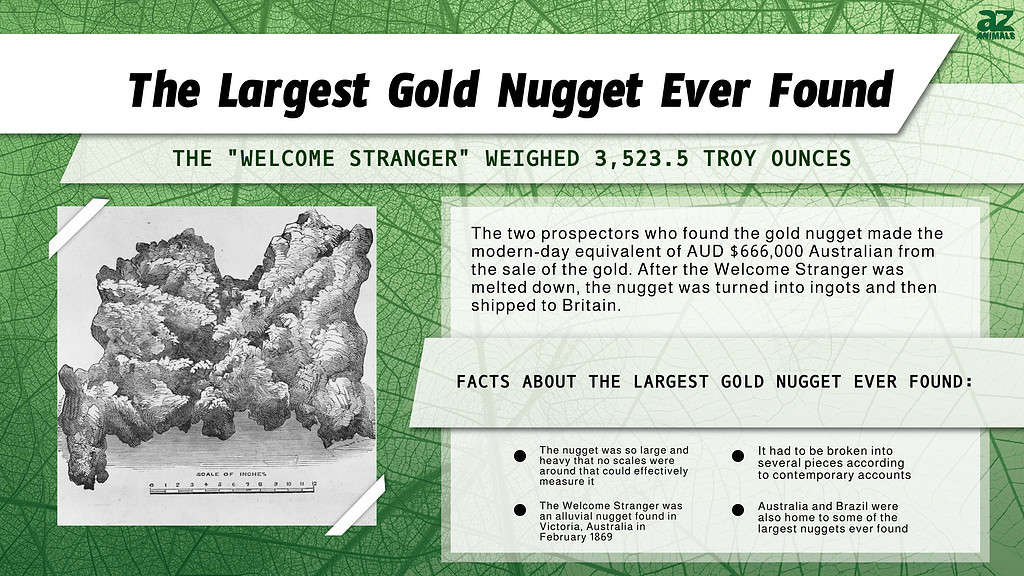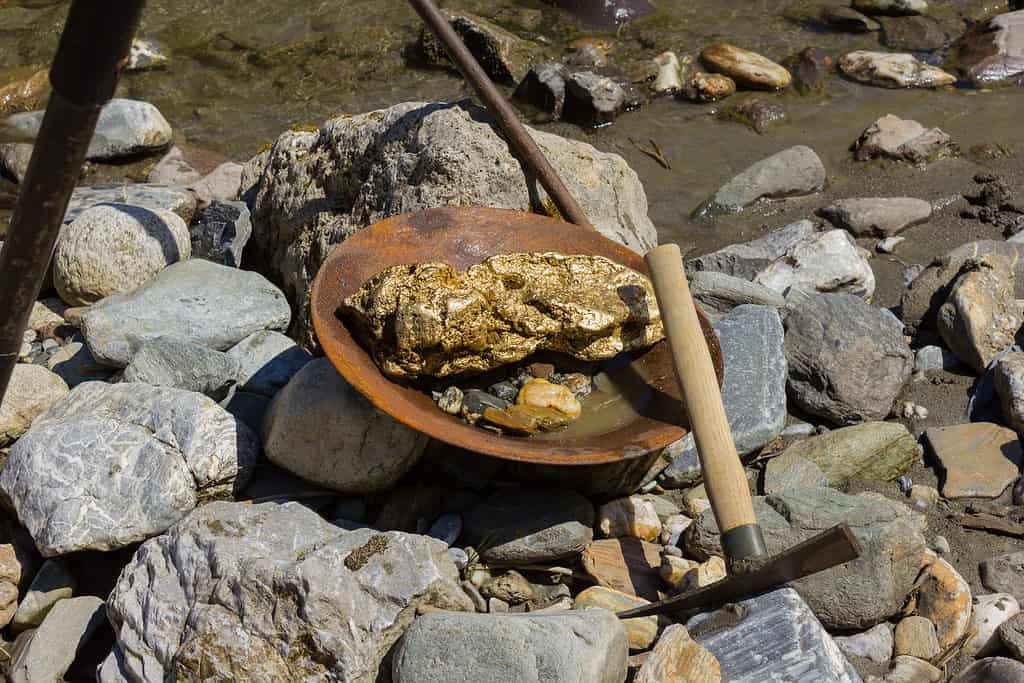Gold is one of the most famous precious metals around today. Gold has been used as a form of currency, turned into wedding rings, and used to make extravagant versions of things like plating for toilets. We love the color of gold and ascribe it to as many animals as possible. Obtaining gold is not always simple, though. Humans dig this precious metal out of the ground in small and large-scale operations. Today, we will show you the largest gold nugget ever found, show you where it was discovered, and what happened to it.
What Is a Gold Nugget?

Gold nuggets are accumulations of gold
©Roman Bodnarchuk/Shutterstock.com
Before we get too far into our search for the largest gold nugget ever found, we need to decide what makes a gold nugget. The simple definition of a gold nugget is a naturally occurring lump of gold. Humans have mined gold for thousands of years, often finding nuggets that weigh as little as a few grams or those that weigh much more.
Gold nuggets are often found in watercourses such as rivers. These waterways concentrate the gold and it is later recovered by people. Sometimes, individuals can recover gold from rivers using a panning technique. Other times, full gold recovery operations are undertaken to find gold in larger deposits or as a byproduct of other types of mining. Gold has even been found in tailings dams.
A lot of the time, gold is found buried in the ground, interlaced with stone and other elements.
Generally speaking, gold nuggets are found in a few different varieties. Gold nuggets can be embedded in iron or quartz. Extracting all the gold from a nugget is a process that humans have become exceptionally good at.
How Are Gold Nuggets Used?
Gold nuggets themselves are not really used for much. Instead, gold nuggets have to be smelted to separate the gold from the other impurities that are in the rock. This process requires immense amounts of heat, above 2,150 degrees Fahrenheit.
Also, the process is dangerous and can require the use of hazardous materials, like mercury. After the ore is smelted and most of the gold extracted, it goes through refining. Refining removes most of the other impurities from the gold, and many techniques exist to derive the purest gold possible.
One of the newest methods of refining is called electroplating. The basic concept behind this idea is to use an electrolytic cell to separate the gold from its impurities. Essentially, when electricity is passed through the setup, all the other metallic elements in the gold are dissolved.
However, that is not the only available refining process, only the latest one to see widespread use.
What Is the Largest Gold Nugget Ever Found?

The Welcome Stranger was found just an inch below the surface.
©Sergey Mikhaylov/Shutterstock.com
The largest gold nugget ever found was named “Welcome Stranger” and weighed 3,523.5 troy ounces when it was first pulled from the ground and produced 3,123 troy ounces (ozt) of gold when it was refined. The nugget weighed 241 lbs 10 oz when it was pulled from the ground. Moreover, the Welcome Stranger was about 21 inches long and 10 inches thick.
The Welcome Stranger was an alluvial nugget found in Victoria, Australia in February 1869. That means the massive nugget wasn’t mined nor was it panned out of a river. Instead, this large nugget was found just an inch below the surface of the ground by two prospectors named John Deason and Richard Oates
The nugget was so large and heavy that no scales were around that could effectively measure it. Thus, it had to be broken into several pieces according to contemporary accounts.
The two prospectors who found the gold nugget made the modern-day equivalent of AUD $666,000 Australian from the sale of the gold. After the Welcome Stranger was melted down, the nugget was turned into ingots and then shipped to Britain.
Interestingly, there was little fanfare at the time of the nugget’s discovery. The discovery came during a gold rush in this part of Australia. The gold was smelted, turned into ingots, and shipped away before a big fuss was made over its discovery.

What Is the Largest Gold Specimen Ever Found?

Gold specimens are often found connected to other rocks
©anne-tipodees/Shutterstock.com
We know that gold nuggets are naturally occurring native gold that is concentrated in a single place often after passing through waterways. However, gold specimens are technically different. These are masses that are attached to rock and have not been water-worn.
The largest gold specimen ever discovered was called Holtermann’s Nugget, and it was found in the Star of Hope Mine in New South Wales, Australia in 1872. This mass of gold, quartz, and rock weighed 10,229 oz when it was pulled from the earth. It measured 144.8 cm by 66 cm by 10.2 cm, a massive specimen.
About 3,000 troy ounces of gold were extracted from the specimen over time, and that was worth about AuD $7 million in modern currency. Once the gold was extracted, the large specimen ceased to be, but replicas of the record-setting stone exist.

These large gold nuggets can’t compare with the “Welcome Stranger”.
©Flugklick/Shutterstock.com
What is the Largest Gold Nugget Around Today?
The Pepita Canaa is the largest gold nugget that exists today. This gold nugget has about 1,682 troy ounces of gold within it. Yet, a little over 10% of the nugget is stone, so the world’s largest gold nugget actually looks like a large mound of brownish-gray stone.
The Pepita Canaa weighs about 134 lbs, and it is on display in Museu de Valores do Banco Central in Brazil, the country in which it was discovered. That makes this nugget unusual because most of the largest gold nuggets are simply smelted, refined, and then sold immediately.
Although the Pepita Canaa is still a large nugget, it’s not close to the largest gold nugget ever found. The Welcome Stranger was a much larger gold nugget and was a nugget. While Holtermann’s Nugget might bear the name, it was technically not a nugget. Thus, we can’t put it in the first place on our list.
Nevertheless, it’s interesting to know just how many of the largest nuggets and gold specimens that exist come from one part of the world. Although the U.S. is famous for its gold rushes, Australia and Brazil were also home to some of the largest nuggets ever found!
Where is Victoria Located on a Map?
The Welcome Stranger was an alluvial nugget found in Victoria, Australia, in February 1869. Victoria is a state in southeast Australia. It has a beach to the south that borders the Bass Strait and is near the island state of Tasmania. Melbourne is its capital.
The photo featured at the top of this post is © current value/Shutterstock.com
Thank you for reading! Have some feedback for us? Contact the AZ Animals editorial team.






